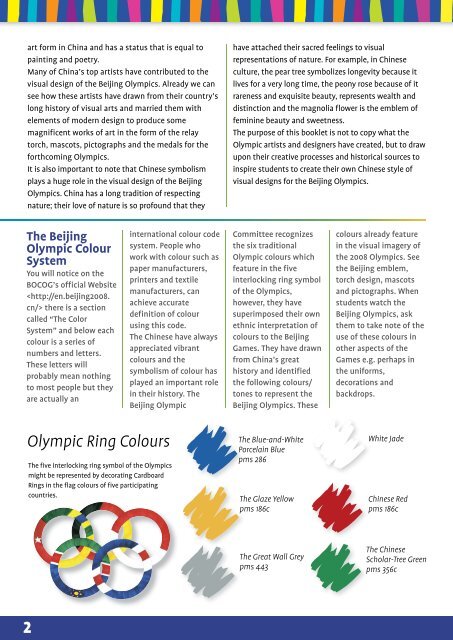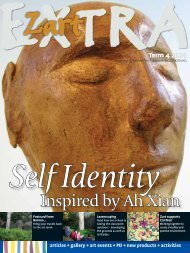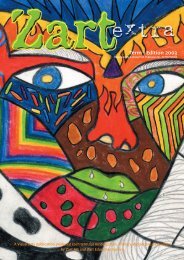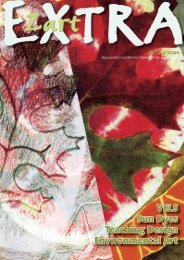Create successful ePaper yourself
Turn your PDF publications into a flip-book with our unique Google optimized e-Paper software.
art form in China and has a status that is equal topainting and poetry.Many of China’s top artists have contributed to thevisual design of the Beijing <strong>Olympic</strong>s. Already we cansee how these artists have drawn from their country’slong history of visual arts and married them withelements of modern design to produce somemagnificent works of art in the form of the relaytorch, mascots, pictographs and the medals for theforthcoming <strong>Olympic</strong>s.It is also important to note that Chinese symbolismplays a huge role in the visual design of the Beijing<strong>Olympic</strong>s. China has a long tradition of respectingnature; their love of nature is so profound that theyhave attached their sacred feelings to visualrepresentations of nature. For example, in Chineseculture, the pear tree symbolizes longevity because itlives for a very long time, the peony rose because of itrareness and exquisite beauty, represents wealth anddistinction and the magnolia flower is the emblem offeminine beauty and sweetness.The purpose of this booklet is not to copy what the<strong>Olympic</strong> artists and designers have created, but to drawupon their creative processes and historical sources toinspire students to create their own Chinese style ofvisual designs for the Beijing <strong>Olympic</strong>s.The Beijing<strong>Olympic</strong> ColourSystemYou will notice on theBOCOG’s official Website there is a sectioncalled “The ColorSystem” and below eachcolour is a series ofnumbers and letters.These letters willprobably mean nothingto most people but theyare actually aninternational colour codesystem. People whowork with colour such aspaper manufacturers,printers and textilemanufacturers, canachieve accuratedefinition of colourusing this code.The Chinese have alwaysappreciated vibrantcolours and thesymbolism of colour hasplayed an important rolein their history. TheBeijing <strong>Olympic</strong>Committee recognizesthe six traditional<strong>Olympic</strong> colours whichfeature in the fiveinterlocking ring symbolof the <strong>Olympic</strong>s,however, they havesuperimposed their ownethnic interpretation ofcolours to the Beijing<strong>Games</strong>. They have drawnfrom China’s greathistory and identifiedthe following colours/tones to represent theBeijing <strong>Olympic</strong>s. Thesecolours already featurein the visual imagery ofthe 2008 <strong>Olympic</strong>s. Seethe Beijing emblem,torch design, mascotsand pictographs. Whenstudents watch theBeijing <strong>Olympic</strong>s, askthem to take note of theuse of these colours inother aspects of the<strong>Games</strong> e.g. perhaps inthe uniforms,decorations andbackdrops.<strong>Olympic</strong> Ring ColoursThe five interlocking ring symbol of the <strong>Olympic</strong>smight be represented by decorating CardboardRings in the flag colours of five participatingcountries.The Blue-and-WhitePorcelain Bluepms 286The Glaze Yellowpms 186cWhite JadeChinese Redpms 186cThe Great Wall Greypms 443The ChineseScholar-Tree Greenpms 356c2
















